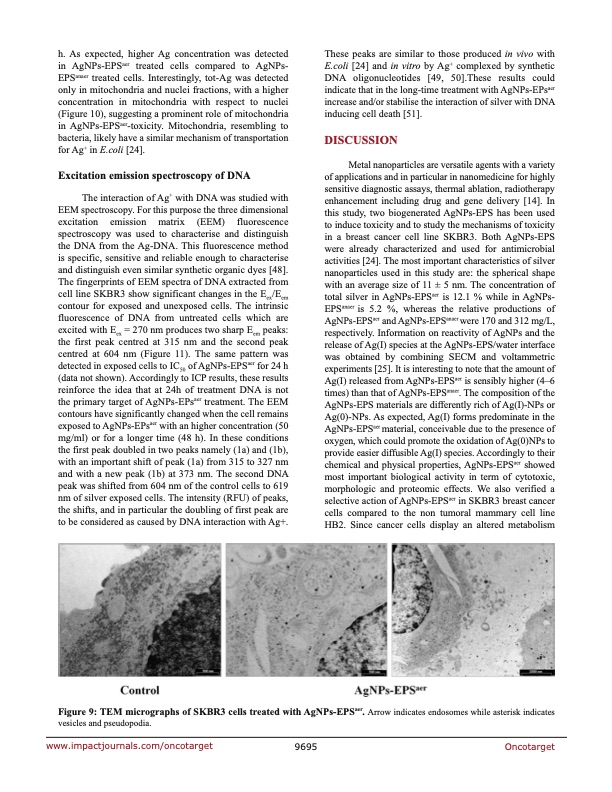
PDF Publication Title:
Text from PDF Page: 011
h. As expected, higher Ag concentration was detected in AgNPs-EPSaer treated cells compared to AgNPs- EPSanaer treated cells. Interestingly, tot-Ag was detected only in mitochondria and nuclei fractions, with a higher concentration in mitochondria with respect to nuclei (Figure 10), suggesting a prominent role of mitochondria in AgNPs-EPSaer-toxicity. Mitochondria, resembling to bacteria, likely have a similar mechanism of transportation for Ag+ in E.coli [24]. Excitation emission spectroscopy of DNA The interaction of Ag+ with DNA was studied with EEM spectroscopy. For this purpose the three dimensional excitation emission matrix (EEM) fluorescence spectroscopy was used to characterise and distinguish the DNA from the Ag-DNA. This fluorescence method is specific, sensitive and reliable enough to characterise and distinguish even similar synthetic organic dyes [48]. The fingerprints of EEM spectra of DNA extracted from cell line SKBR3 show significant changes in the Eex/Eem contour for exposed and unexposed cells. The intrinsic fluorescence of DNA from untreated cells which are excited with Eex = 270 nm produces two sharp Eem peaks: the first peak centred at 315 nm and the second peak centred at 604 nm (Figure 11). The same pattern was detected in exposed cells to IC50 of AgNPs-EPSaer for 24 h (data not shown). Accordingly to ICP results, these results reinforce the idea that at 24h of treatment DNA is not the primary target of AgNPs-EPsaer treatment. The EEM contours have significantly changed when the cell remains exposed to AgNPs-EPsaer with an higher concentration (50 mg/ml) or for a longer time (48 h). In these conditions the first peak doubled in two peaks namely (1a) and (1b), with an important shift of peak (1a) from 315 to 327 nm and with a new peak (1b) at 373 nm. The second DNA peak was shifted from 604 nm of the control cells to 619 nm of silver exposed cells. The intensity (RFU) of peaks, the shifts, and in particular the doubling of first peak are to be considered as caused by DNA interaction with Ag+. These peaks are similar to those produced in vivo with E.coli [24] and in vitro by Ag+ complexed by synthetic DNA oligonucleotides [49, 50].These results could indicate that in the long-time treatment with AgNPs-EPsaer increase and/or stabilise the interaction of silver with DNA inducing cell death [51]. DISCUSSION Metal nanoparticles are versatile agents with a variety of applications and in particular in nanomedicine for highly sensitive diagnostic assays, thermal ablation, radiotherapy enhancement including drug and gene delivery [14]. In this study, two biogenerated AgNPs-EPS has been used to induce toxicity and to study the mechanisms of toxicity in a breast cancer cell line SKBR3. Both AgNPs-EPS were already characterized and used for antimicrobial activities [24]. The most important characteristics of silver nanoparticles used in this study are: the spherical shape with an average size of 11 ± 5 nm. The concentration of total silver in AgNPs-EPSaer is 12.1 % while in AgNPs- EPSanaer is 5.2 %, whereas the relative productions of AgNPs-EPSaer and AgNPs-EPSanaer were 170 and 312 mg/L, respectively. Information on reactivity of AgNPs and the release of Ag(I) species at the AgNPs-EPS/water interface was obtained by combining SECM and voltammetric experiments [25]. It is interesting to note that the amount of Ag(I) released from AgNPs-EPSaer is sensibly higher (4–6 times) than that of AgNPs-EPSanaer. The composition of the AgNPs-EPS materials are differently rich of Ag(I)-NPs or Ag(0)-NPs. As expected, Ag(I) forms predominate in the AgNPs-EPSaer material, conceivable due to the presence of oxygen, which could promote the oxidation of Ag(0)NPs to provide easier diffusible Ag(I) species. Accordingly to their chemical and physical properties, AgNPs-EPSaer showed most important biological activity in term of cytotoxic, morphologic and proteomic effects. We also verified a selective action of AgNPs-EPSaer in SKBR3 breast cancer cells compared to the non tumoral mammary cell line HB2. Since cancer cells display an altered metabolism Figure 9: TEM micrographs of SKBR3 cells treated with AgNPs-EPSaer. Arrow indicates endosomes while asterisk indicates vesicles and pseudopodia. www.impactjournals.com/oncotarget 9695 OncotargetPDF Image | Anticancer activity of biogenerated silver nanoparticles

PDF Search Title:
Anticancer activity of biogenerated silver nanoparticlesOriginal File Name Searched:
oncotarget-09-9685.pdfDIY PDF Search: Google It | Yahoo | Bing
Turbine and System Plans CAD CAM: Special for this month, any plans are $10,000 for complete Cad/Cam blueprints. License is for one build. Try before you buy a production license. More Info
Waste Heat Power Technology: Organic Rankine Cycle uses waste heat to make electricity, shaft horsepower and cooling. More Info
All Turbine and System Products: Infinity Turbine ORD systems, turbine generator sets, build plans and more to use your waste heat from 30C to 100C. More Info
CO2 Phase Change Demonstrator: CO2 goes supercritical at 30 C. This is a experimental platform which you can use to demonstrate phase change with low heat. Includes integration area for small CO2 turbine, static generator, and more. This can also be used for a GTL Gas to Liquids experimental platform. More Info
Introducing the Infinity Turbine Products Infinity Turbine develops and builds systems for making power from waste heat. It also is working on innovative strategies for storing, making, and deploying energy. More Info
Need Strategy? Use our Consulting and analyst services Infinity Turbine LLC is pleased to announce its consulting and analyst services. We have worked in the renewable energy industry as a researcher, developing sales and markets, along with may inventions and innovations. More Info
Made in USA with Global Energy Millennial Web Engine These pages were made with the Global Energy Web PDF Engine using Filemaker (Claris) software.
Infinity Turbine Developing Spinning Disc Reactor SDR or Spinning Disc Reactors reduce processing time for liquid production of Silver Nanoparticles.
| CONTACT TEL: 608-238-6001 Email: greg@infinityturbine.com | RSS | AMP |